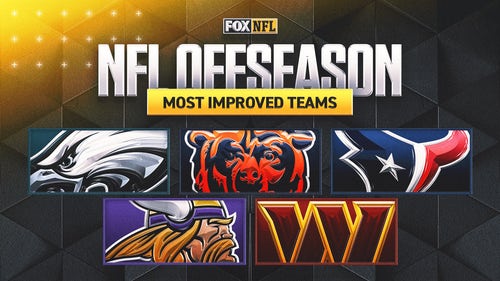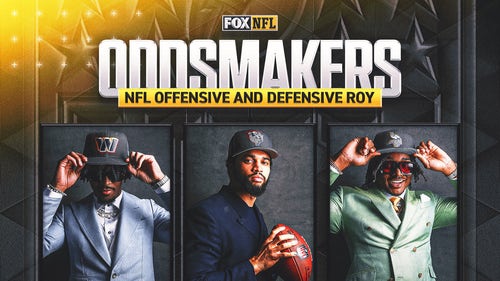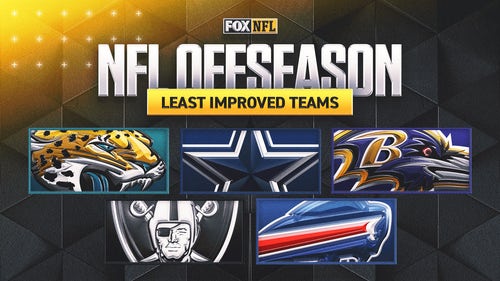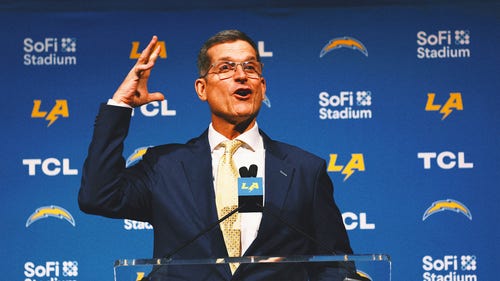
How the NFL could benefit from a developmental league

Imagine a league in which NFL hopefuls can spend a season refining their techniques before taking the big stage. Imagine an academy at a centralized location, where those same players can stay in shape, get individualized coaching and essentially become the league's waiver wire during the regular season.
The NFL hasn't had a developmental league since NFL Europe shuttered in 2007, but it has been researching different models that can sustain fiscal success and grow the game. A true feeder system would include everyone from groundskeepers to offensive guards to general managers.
"Our goal is to develop an uninterrupted and qualified pipeline of players, coaches, officials, trainers, front office and other personnel," NFL vice president of football operations Troy Vincent told FOXSports.com. "We believe that new ways to develop the vast pool of football talent is imperative and are considering how that could be done economically and effectively."
Despite losing millions of dollars annually, NFL Europe was an 18-year attempt to heighten awareness for the sport of football globally and generate interest in new markets. Instead, it became a place where players could hone their skills if they couldn't make a big-league roster.
"The challenge is how do you create that marriage between the developmental league -- that has the purpose for developing players and helps maintain a high level of play – and having a functional business model," former NFL Europe director and current West Virginia athletic director Oliver Luck said.
Other important logistics, of course, must be thought through before a proposal reaches the NFL competition committee. Where and -- most importantly -- when would the games be played? How long would the season be? Who would compensate the players? Would players be under the guidance of the NFL's 32 teams?
The 2011 collective bargaining agreement brought about strict offseason and regular-season rules regarding contact in practice. The lack of time spent in pads could ultimately hurt players on the bubble looking to make a team.
Two-a-days -- once a training camp ritual -- were replaced by one full-contact padded practice per day along with a walkthrough period. During the regular season, teams are allowed only 14 full-contact practices for the year, with 11 of those coming in the first 11 weeks of the season.
"The lack of contact in the offseason and during the season is great for the veterans, but it has really hindered the front-seven-type players," agent Steve Caric told FOXSports.com in June. "Those guys really need repetition at full speed in pads to hone their craft and become better. This isn't a knock on the CBA because guys are able to preserve their bodies in the offseason, but I also think if you're a young player you need somewhere where you can play and get repetitions to get better."
Before the beginning of each regular season, teams must cut 90-man rosters to 53, plus an eight-player practice squad. At least 928 players are forced to wait by their phones and hope.
"When you see how teams manipulate the rosters during the season, they'd love to have the chance to expand their rosters," agent David Canter said. "There is so much talent out there, and teams don't have the time to spend to develop it with the new schedule and new CBA because players are in the building less."
Because players in the developmental league would be professionals, a new arm of the union and league's working agreement may also need to be collectively bargained. That would present a set of challenges, including details such as workers' rights, health and safety agreements, and injury protection.
The NFLPA declined comment on such matters because the union hasn’t been informed of the NFL’s plans for a developmental league.
Though no timetable has been set, more than 200 proposals have entered the league office since April, when Vincent first mentioned his interest in establishing a developmental league. It has become one of the offseason's most widely discussed topics. Coming up with a properly vetted model is of most importance. With all of that considered, FOXSports.com takes a look at some of the most pressing questions facing an NFL developmental league.
What's the purpose of a developmental league?

Kurt Warner is considered one of NFL Europe's greatest success stories.
With the Canadian Football and Arena leagues serving as last-ditch opportunities for some players, the NFL developmental league could act as a true feeder system for second-tier talent. By attracting talent with the opportunity to potentially play at the highest level, the NFL would have the chance to own a larger portion of the sports calendar. Offseason events such as the NFL Combine and NFL Draft have generated record-sized ratings in recent years.
With the appetite for football larger than ever, a minor-league infrastructure has the potential to become a profitable business. The issue: Would the league be launched to truly develop all football talent? Or would it be another opportunity for the NFL to expand its revenue pie and penetrate new markets? Balancing the two objectives is delicate.
Ultimately, the league could bid out its TV rights to rival networks and sell each minor-league franchise to independent owners. Though that would create an immediate return on investment, a problem that emerges from the latter scenario is owners want to grow their brands, sell tickets and win games.
"It would be a nice addition to player development in general," former Jets general manager Mike Tannenbaum said. "Typically, the 46th to 53rd player and eight-player practice squad is a developmental tool, so it would be just another tool for the team to keep developing players. I think it would make the sport better over time. They are getting more reps. They are getting more skills. I see it as a long-term positive for the sport.
"I certainly believe if it's done the right way, it can enhance a strong brand."
In NFL Europe's nearly two decades of operation, the NFL learned the value of having a developmental league, but the model wasn't financially stable. Success stories like those of former NFL Europe players Kurt Warner, Adam Vinatieri and Jake Delhomme were rare. Oftentimes, teams sent players who needed a year or two of seasoning to NFL Europe to work on their craft and get better.
"Some teams embraced it more than others," Luck said. "The instructions were to go play. Film would be watched. Assistant coaches would come over and watch them in action. They'd watch every practice, every game. They'd talk to our NFL Europe coaches about what the player's attitude might be like because they were about to sign a guy on a two-year deal and before that they'd want to see if he could play. I think that need is still there because there are a lot of guys in the league that don't get a lot of playing time. You can't put your backup left tackle on too many special teams units.
"It was very beneficial. The NFL GMs thought it was beneficial. In many instances, they would say, 'This really helped us to decide to not sign a guy.' But that's just as important, too."
Aside from the players and coaches, the league hopes to recreate every aspect of the football universe to make a developmental league a true pipeline to the NFL. Game officials, training staffs and other key roles on Sundays would not be overlooked. In fact, depending on when the developmental league's season would be played, the NFL could make more officials full-time employees. More live repetitions for the officials would only help them in the fall when it counts.
Another benefit of adding such a league is having a space to test out innovations like helmet cams, GPS-tracking devices and heart-rate monitors on every player, and laser-beam technology on each goal line. It would even give the NFL a credible testing ground for annual rule changes like the recent proposals to eliminate kickoffs and extra points.
When would games be played?

A developmental league would likely need to fit within the league's offseason schedule
One of the biggest challenges is finding a timeframe that fits within the league's offseason Combine and Draft schedule. Roster size and the physical nature of the game make it difficult to have a traditional minor league system during the NFL regular season. Though the thought of general managers calling up and demoting or promoting players from a minor league is intriguing, it's not realistic because teams want their players fresh and not dinged up when they sign them.
A league that would begin in March and April – after the Combine and before the Draft – would certainly be possible. As one source explained, a developmental league would likely play anywhere from a six- to eight-week schedule. With a week of training camp and a period to sign players to reserve/futures contracts, a shortened schedule and a championship week, players would still have enough time to report to their NFL teams' organized team activities by the third week in May.
With an eight-team model for an expansion league, one proposal includes each division (AFC West, NFC North, etc.) in the NFL being represented by one team in the minor league. Twenty-five percent of each developmental team's player roster would be under contract with one NFL franchise.
An allocation system, in which each NFL club is mandated to option 10 to 12 players, would give teams the ability to develop the players in their offseason training programs. It would also allow players to learn the team's on-field schemes and concepts and give them a better chance at making the parent club the following season. Such a setup would essentially be an extension of the team's eight-man practice squad.
How would an academy system work?
If an allocation system weren't used and the developmental league players weren't under contract with the NFL's 32 clubs, an academy would essentially work like a waiver wire.
Once final cutdowns were made in September, a specified number of players could be invited to a single location where they could train and stay in shape. Players could get some form of coaching on the field and in the classroom, and train in strength and conditioning programs. If a team wanted to send a personnel representative, it could monitor and track the players' progress. This would be beneficial to a team that falls victim to a crucial injury and needs to fill a roster spot. One scenario, according to Vincent, includes both the developmental league and the academy working in tandem.
"The NFL has utilized college football as the primary feeder system for a long time and hasn't had to invest much of anything," former Browns general manager and current Senior Bowl president Phil Savage said. "With having so many juniors come into the league, you have guys now that aren't going to last more than a year or two and they don't have anywhere to go. They don't have their degrees and so on.
"I don't think it would be a bad investment for the league to pour some money back into another way for a player to keep his career going and potentially develop over the course over a year or two."
Instead of having players train by themselves and work part-time jobs while they wait for a phone call, this serves as a good option to keep guys active.
Who would play in a developmental league?
When the regular season concluded each year, teams could sign players to reserve/futures contracts, which would be a way to stash them on 90-man rosters that would affect the following season's salary cap. A contract typically would be a one- or two-year deal for the league minimum based on the player's years of NFL experience. To be eligible for such a deal, a player would need to not have been on an active roster at the end of the regular season. Essentially, if a player were still a free agent after Week 17, he would be up for grabs. A majority of the developmental league would be comprised of these players.
"You have 400 legitimate players entering the league each year, which means there are 400 legitimate players that have to leave the league each year," agent Greg Linton said. "If a player is good, they get selected in the first through fourth rounds, so the only players that you'd be developing is seventh rounders and free agents. Is the NFL really concerned with developing that guy?"
In a win-now league, jobs are on the line each week for general managers and head coaches. It's understandable that they don't make it their priority to develop players who are long shots. They simply don't have the time. Under a leaguewide allocation system, teams would have a level playing field in investing resources in a player rehabbing a serious injury or someone who needs to refine his skillset. It would be a good way to keep some players on the same team, too.
"One of the key issues with NFL Europe was there was too much player rotation," former Frankfurt Galaxy general manager Tilman Engel said. "I remember one year when we celebrated the championship and then the next year the team that took the field as the defending champion only had one, maybe two returning US players, who made up for the bulk of the roster."
This challenge is one all minor-league systems face. Short-term deals, coupled with being a league that's always second fiddle, makes continuity difficult. One priority of any developmental league would be keeping the standard of play at a high level. Though players would be compensated for their play in the developmental league, the incentive would be to make it to the NFL and earn a big-league paycheck. For that to happen, staying healthy and showing teams they could adapt to multiple schemes is where their minds would be at.
"The (fans) need to understand that the organization and the players are there to play their hearts out for them and not execute the player development directives of some player personnel director for a pro club 2,000 miles away," Engel said.
Where would games be played?

Could a site like Ladd-Peebles Stadium (Mobile, Ala.) be a potential place to play?
Figuring out where to stage games would be tricky. While the league is researching cities with a strong football appetite year-round, some suggestions have placed the highest emphasis on cutting costs. If the developmental league could land a TV agreement with one of the large networks, that might create enough incoming revenue to keep the league afloat. Travel costs ultimately sank NFL Europe, so the league might be wise to look at a model where teams are stationed closely together.
"It doesn't matter how many fans are in the stands," Savage said. "And you don't have to worry about renting out the large stadiums, which are going to require people to man the gates and work the parking lot. That's why it makes sense to me to set it up like a Grapefruit or a Cactus League where you'd have four teams in a specific area and there wouldn't be the travel costs to cover."
Other factors that will be taken into account are where the largest density of NFL teams are already stationed, hospitable weather and outdoor playing surfaces. Defusing potential issues such as which states – Arizona, Florida, Texas, etc. – would be first in line to host the games and benefit from the extra income must be addressed ahead of time.
"The key thing is finding that business model," Luck said. "I think ultimately the NFL relies on the colleges to provide that function, and I think the colleges do a pretty good job doing that, quite honestly. The increase in the level of play of the last 20 years has certainly helped the NFL put out a better product. A developmental system would only strengthen the brand."















































































































































